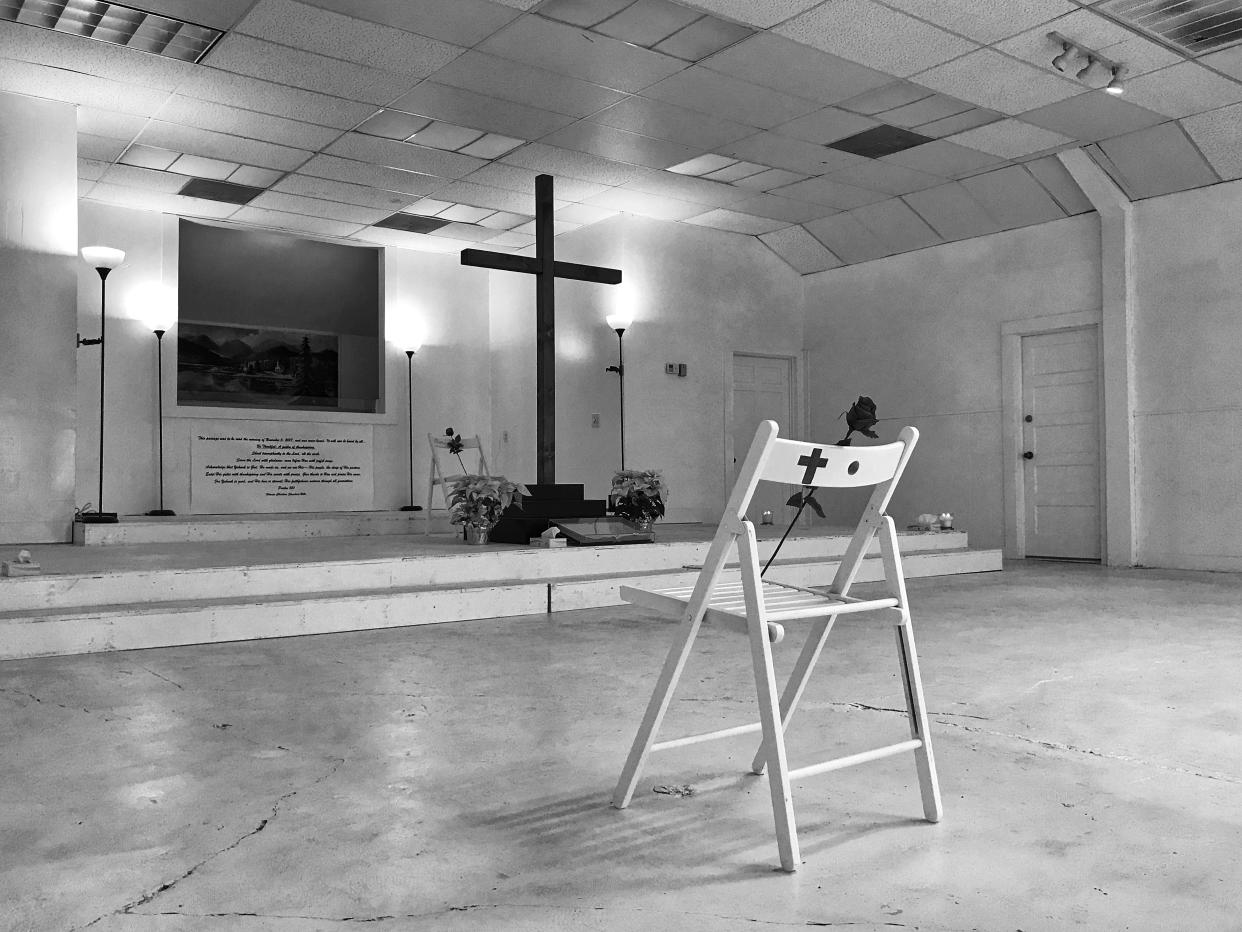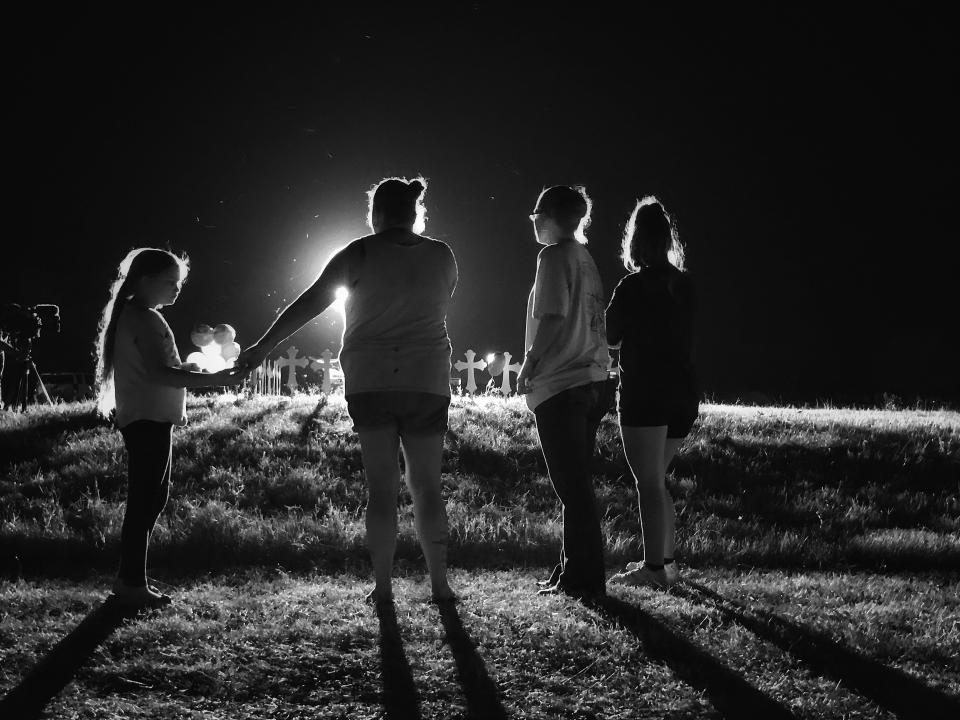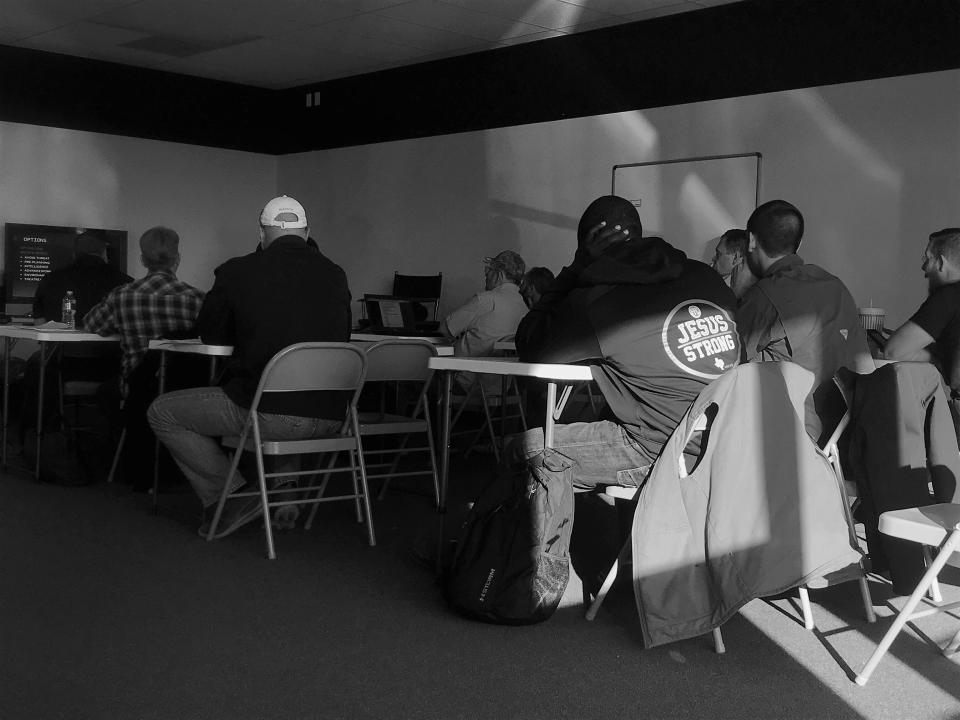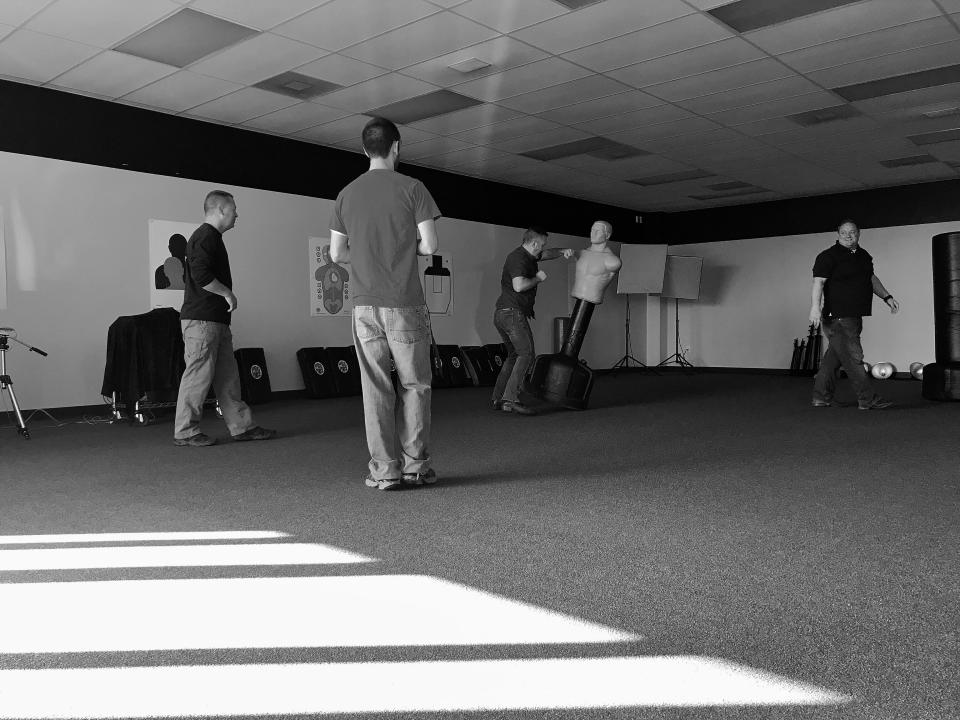In wake of church shootings, pastors and worshipers arm themselves to shoot back

SANTA ANNA, Texas — When Kevin Roman thinks about what happened at that tiny church in Sutherland Springs last November, he considers the clock: seven minutes.
That’s how long it took for a masked gunman to spray hundreds of bullets in the sanctuary of First Baptist Church during the Sunday morning service on Nov. 5, killing half the congregation of around 50 and wounding 20 others. Seven minutes is all it took to enact the worst mass shooting in Texas history and the worst ever at a church in the United States. Just seven minutes was all it took to rip out the heart of a tiny community, to inflict the kind of pain on families that will never heal.
Roman lives hundreds of miles away, in a tiny unincorporated West Texas town called Valera. Like Sutherland Springs, Valera is a blip on the map, a one-stoplight village of roughly 80 people where everyone knows everyone else. There’s a post office, a barbecue restaurant and the Valera Baptist Church, where Roman has been pastor for the last three years. The congregation of 30 or so meets Sundays in the small white chapel a few blocks off state highway 67 in heavily rural Coleman County that appears to have more cows than cops.
Last year, when the barbecue restaurant was robbed, it took the county sheriff almost 30 minutes to respond. Roman thought of the robbery on that fateful November morning, as he heard early reports of the massacre in Sutherland Springs. He considered the fate of his own church, smaller but equally remote. What would they do if a crazed gunman suddenly showed up on their doorstep? Would there be anyone to protect them? Could they protect themselves?

“Sutherland Springs was a punch in the gut because, out in the middle of nowhere, you forget about danger,” Roman said.
His congregants also watched the news and began to think about their safety. Some of the Sunday regulars began bringing their guns to church, including a woman who kept one in her handbag. Nobody talked about it. It just happened. They started locking the church door during services, and a man positioned himself in the last pew to keep watch. It still didn’t feel like enough.
Roman resolved to come up with a plan for how to keep his church safe in the event of the unthinkable. “Even if nothing happens, I didn’t want to be that pastor who wasn’t prepared,” Roman said.
On a recent Wednesday night, Roman found himself 15 miles down the road on one of the front pews at the First Baptist Church in nearby Santa Anna. He was one of about 50 small-town pastors and church congregants from around the region attending a $25-per-person seminar on church security taught by Jimmy Meeks, a retired police officer turned minister who travels the country advocating for churches to be better prepared for violent attacks like the one in Sutherland Springs. Unlike other church security experts, he makes little money on the ministry. The tickets usually cover his travel costs and that’s it.
Meeks calls his mission the Sheepdog Seminars, and in recent months, he’s been on the road almost nonstop, traveling to churches throughout Texas and as far away as Nevada, Florida, Kentucky and Ohio, called upon by pastors to spread awareness that not even the sacred house of God is immune from bloodshed in an era of seemingly endless mass shootings.

“What happened in Sutherland Springs, as horrible as that was, it was not unique,” Meeks said as he prepared to take the pulpit in Santa Anna. “Violence happens all the time in churches or on faith-based property, but for some reason, people in the church still operate as though this could never happen to them. [They say,] ‘No, Lord, not at my church.’ And I say, ‘Don’t you remember Charleston? Don’t you remember Colorado Springs? Or Fort Worth? Don’t you remember this town or the other?’ People need to wake up.”
For almost three hours, Meeks, dressed in a Western-style shirt, faded jeans and cowboy boots, marched up and down the aisle of the small sanctuary in Santa Anna, alternating between the calm voice of the cop he used to be in the suburbs of Fort Worth, where he still lives, and a fire-and-brimstone preacher passionately trying to stir the church body out of what he describes as “complacency.” Invoking a litany of past church attacks, often with his voice choked and tears in his eyes, Meeks again and again warned that what happened in Sutherland Springs could happen anywhere, in any church, big or small.
Although recent headlines might suggest otherwise, it is still safe to go to church on Sunday morning. As opposed to how it handles school shootings, the FBI does not keep a specific tally of acts of violence at faith-based institutions, so the research is largely left to outside experts. But given the millions of institutions of faith in the country, the ratio of deadly crime is, on average, small.
Since 1999, there have been around 1,700 “deadly force” incidents at houses of worship, including mosques and synagogues, according to Carl Chinn, a church security expert in Colorado Springs, Colo. Even though there are few incidents on average, church shootings are often high profile. According to Chinn’s data, roughly 1,000 of those deadly force incidents included the use of a gun, and in nearly 500 cases, someone was killed.
Experts say that what’s happening at churches is not necessarily a sign of growing anger at religion, but rather a sign that houses of worship are not immune from the rash of deadly shootings that seem to be growing in number in recent years. People like Meeks argue that churches need to be prepared and aware of what is happening in the society around them.
“You need to be ready!” Meeks shouted. Citing the Old Testament story of David versus Goliath, he rejected the interpretation that the young warrior was an underdog who had simply overcome his enemy with the help of the Lord. David, he said, had “trained” to face his enemy — just as churches must now train and prepare for potential attacks.
“David was conscious of the threats,” Meeks declared. “Are you conscious of the threats?”
For churches, the more difficult question now may not simply be whether they are aware or even preparing for the threats. Just as Meeks’s schedule is crammed with dozens of seminars in coming months, consultants and other organizations that specialize in church security have been overwhelmed with training requests from congregations all over the country in the aftermath of Sutherland Springs as shaken churches grapple with the fear that an attacker could target their place of worship. Some waiting lists are reportedly more than a year long, already scheduled well into 2019.

In Texas, the question of security has ignited a separate debate over how far a church should go in trying to protect the flock, especially small-town churches that can’t afford to hire police or professional security guards. Many law enforcement officials and security experts say it is a risk for churches to rely on volunteer security or gun-toting congregants who may not have the proper training to interpret a genuine threat or how to respond. But Texas officials, including state Attorney General Ken Paxton, have said what happened in Sutherland Springs is an argument for more armed parishioners since they may be a church’s only line of defense.
“We need people in churches … at least arming some of the parishioners or the congregation so that they can respond if something like this, when something like this happens again,” Paxton told Fox News on Nov. 5, hours after the Sutherland Springs shooting.
But even in gun-friendly Texas, where an open-carry law has been on the books since 2016, some churches have been reluctant to allow congregants to carry their weapons during service, even concealed. The churches are fearful of the tension the presence of a gun might cause or the message it might send in an environment that is supposed to be welcoming to outsiders. Even now, some churches around the state say they believe they should rely on their faith in God, not on guns, to protect them from potential attacks.
“There is a fundamental question about who is the church and what are we about. Are we going to be gun-carrying and put trust in redemptive violence?” Kyle Childress, the pastor of Austin Heights Baptist Church in Nacogdoches, Texas, told the Austin American-Statesman in December. “I don’t believe the way of Jesus Christ teaches that.”
Before the Sutherland Springs shooting, several major church groups in Texas, including leaders of the United Methodist Church and the Episcopal Diocese of Texas, had advised their membership to ban weapons from services. Citing the Catholic doctrine that the real presence of Jesus Christ exists inside the sanctuary, dioceses in major cities, including Dallas, San Antonio and Houston, banned guns. But in the aftermath of Sutherland Springs, church leaders of various denominations have faced pressure to reconsider their positions on weapons.
In November, just a day after the shooting in South Texas, the Diocese of Dallas said it would not formally lift its ban on the open or concealed carry of firearms inside its churches, but it advised its parishes to consider removing outdoor signs that advertised the prohibition on guns out of fear it would make the churches more vulnerable to attack. But the move effectively allowed the carry of weapons, since state law requires any business banning guns to install a public sign formally stating that policy.

Outside of Texas, the Sutherland Springs attack sparked new calls for gun control measures — the same response that happened just weeks earlier after the Oct. 1 mass shooting in Las Vegas and other deadly events before that. But in the Lone Star State, the opposite happened, especially in the small towns around Sutherland Springs. Worried residents increasingly saw firearms as their only reliable line of protection in an area where law enforcement isn’t always around the corner.
Gun stores in Wilson County, where Sutherland Springs is located, have reported an uptick in the sale of firearms and applications for concealed weapons since November, including from local pastors looking to protect their flock. It’s not unheard of for a pastor to carry a gun in the pulpit. Frank Pomeroy, the head pastor at the First Baptist Church in Sutherland Springs, told reporters after the shooting that he regularly carried his weapon to church. But on that Sunday morning when his church was attacked, Pomeroy was in Oklahoma City taking a class to be a licensed gun instructor for a youth class on pistols. His daughter Annabelle, just 14, was killed in the shooting. The pastor has admitted to agonizing over whether he could have stopped the attack.
“In a way, I think that if I were there I could have done more,” Pomeroy told the New York Times after the shooting. “But who is to say?”
Church leaders in the heavily rural area had operated on a mostly “don’t ask, don’t tell” approach to carrying firearms during services even before the Nov. 5 shooting and now say they have noticed more guns on Sunday mornings. “I honestly welcome it,” said a pastor from Floresville, Texas, a town neighboring Sutherland Springs. The pastor declined to be identified by name because he did not want his church to be a target. “People are nervous, but they aren’t afraid of guns around here,” he said. “They are afraid of someone barging in and shooting them.”
In Sutherland Springs, Devin Kelley, the gunman, was ultimately stopped when he left the church and came under fire from Stephen Willeford, a church neighbor who had grabbed his own weapon when he heard gunfire across the street. Although he was wearing ballistic armor, Kelley was shot twice, in the leg and torso, causing him to drop his gun — an AR-556 assault rifle — and flee. He later died of a self-inflicted gunshot wound to the head after Willeford and another man, Johnnie Langendorff, pursued him in a high-speed chase into the countryside.

Police have speculated that Willeford may have stopped Kelley from killing more people. The gunman was believed to have targeted the church in a dispute with his estranged wife’s mother, but she wasn’t in church that morning. Inside Kelley’s vehicle, police found two more guns and additional ammunition. Investigators have hinted he may have had more targets, although they have offered no other details.
In the aftermath of the shooting, some churchgoers in the region appointed themselves to be unofficial guardians of their church, taking inspiration from Willeford’s gun battle with Kelley. At the same time, some churches, especially smaller congregations in rural areas, have sought to set up security teams made up of volunteers — something they couldn’t legally do until recently.
In September, just two months before the Sutherland Springs attack, a new state law went into effect that allowed churches to form security teams without having the training, licensing, insurance and background checks usually required of security guards in the state. Before that, churches that were caught relying on armed volunteers who did not meet state licensing requirement faced fines up to $10,000 and potential jail time — though there’s no record of any organization being charged. Backers of the new law, including Meeks, argued that the old regulations unfairly penalized small churches that couldn’t afford to hire outside security or formally license members of the congregation, leaving them vulnerable.
But opponents of the law have raised concern about the potential danger caused by untrained volunteers who don’t know how to properly use their weapons or identify and respond to a potential threat in the heat of the moment. They say it’s no different from having an unlicensed vigilante sitting in the church pew and have expressed concern about accidents — which have happened in recent weeks.
Just days after the shooting in Sutherland Springs, an 81-year-old man was accidentally shot in the hand and his wife was grazed in the stomach at a church in Tellico Plains, Tenn., after he pulled out his weapon during a church discussion on bringing firearms to church.
That unease over potential accidents and guns in the hands of untrained congregants has only increased in the rush to protect churches in the aftermath of Sutherland Springs.
“Having Bubba there with a gun is not necessarily the best idea,” said Chuck Chadwick, a longtime church security expert and founder of the National Organization of Church Security and Safety Management. He has been training churches on how to protect themselves for more than a decade through Gatekeepers Security Services, a Dallas-area private security firm he and his family operate.

The program, which costs $800, has trained and certified more than 350 parishioners, church staffers and even pastors as state-licensed personal protection officers. It’s based on a curriculum that closely mirrors requirements for private security officers, including training in handguns and hand-to-hand combat. Participants are trained in church-specific scenarios, such as distinguishing potential troublemakers from those who may be showing signs of emotional distress and are seeking help.
“Churches have a unique dilemma because nobody wants to shut the doors to people who need help,” Chadwick said. “But you also have to have people who can detect the difference between whether someone is going up for prayer or whether they are going up to attack the pastor. You don’t always know, and you have to be prepared to act. … That comes from training.”
On a recent weekend, the Gatekeepers class in a suburb outside Dallas included six men from a small church in San Marcos, Texas, a town about 45 minutes north of Sutherland Springs. The group, which included the pastor, had signed up for training after the Nov. 5 shooting.
All the men were gun owners, skilled marksmen who regularly hunted and spent time at the range. But in training the week before, the group had spent time practicing their skills in a simulator designed to give them an idea of what handling a gun might be like in an active-shooter situation. The experience had been overwhelming. “You imagine it’s going to be stressful and chaotic, but it’s so much more intense than you imagine,” one of the men said. “Hopefully, we never experience anything like that in person.”

That morning, the men were going over potential defense tactics in what would be their final hours of training before testing. They practiced punches and kicks on a rubber dummy at the center of the room, moves designed to neutralize a potential assailant without having to use a gun. The training emphasizes that using a gun in the sanctuary should always be the last resort.
Chadwick’s son, William, a licensed bodyguard who runs security for a prominent Dallas pastor, had spent part of the class standing at a dry-erase board, scratching x’s and o’s on the board like a football coach trying to lay out the best possible plays. A circle represented the church sanctuary, and inside the circle were even smaller circles — barrier rings that led to the pulpit in the center. He talked about setting up cameras and where to position security and staff, and walked the men through how to deescalate potentially bad situations.
“Where’s your first line of defense?” he asked. He drew an arrow just outside the circle. “You always need someone here, keeping on eye on the parking lot.”
It was the parking lot outside the church in Sutherland Springs where Kelley had first attracted notice. The gunman had barely parked his SUV, leaving it in the street, when, according to witnesses at a gas station across the street, he jumped out and began firing at the exterior walls of the church before he headed inside the sanctuary.

William Chadwick, a serious but affable man, grows angry just thinking about it. Along with his dad, who was running church security when he was just a kid, he had spent most of his adult life trying to spread the word to churches to be more mindful of potential threats. What happened in Sutherland Springs just seemed senseless to him, and preventable.
“There was no one there to confront him, no one there to stop him,” he said. “I remember people were saying how heartbroken they were, and I was, too. But I was so furious. I was actually angry. There was not a single person there, no gatekeeper, no one to stand in that threshold and tell him no. … When are people going to get serious?”
In Santa Anna, Meeks’s presentation was far more informal. The retired police officer outlined some of the same suggestions emphasized in the Gatekeeper training, including locking certain doors and where to position church staff.
“Get in the parking lot. They are all coming from the parking lot. Nobody’s coming on an airplane. They’re going to pull up in the car in the parking lot, get out and start,” Meeks said. “If you are there to deal with them, there’s a good chance they won’t get inside. You cannot let the shootout take place in the sanctuary, are you hearing me?”

Meeks repeatedly advised the congregants to study mental illness, accusing churches of dancing around a subject that is a more realistic threat than an ISIS-inspired soldier storming the sanctuary. “You need to know what schizophrenia is. You need to know what bipolar means. You need to understand aggression. You got people in your church that got all these diseases,” the former cop said. “Study these things. Why is the church so scared of everything? You ought to be on the phone next week and get somebody out here from mental health services and say, ‘Educate us.’ … Can I get an amen on that?”
“Amen!” a man shouted.
Meeks was blunt that his seminar did not teach the congregants everything they needed to know. “You ain’t ready,” he said. He advised them to enroll in a class like Gatekeepers, if they could afford it. But he acknowledged that many small churches simply didn’t have the money. So he repeatedly advised them to go back to their churches and train and practice security scenarios repeatedly.

“If your church safety team is not trained, I don’t even know that you should have one. You’re nothing but a liability to the whole church,” Meeks said. “Because when he shows up to kill, it is going to be sheer chaos and hell like you never dreamed possible. You better start training, you better be practicing.”
Before he ended the service, Meeks took up a collection, asking for donations to buy a new bulletproof vest for a local police officer who sat in the back. He had recognized instantly that the one the cop was wearing was so old it could barely withstand a conventional gunshot, much less fire from the kind of military-style assault rifles used in recent mass shootings. Then Meeks sent his audience off with a prayer — though he kept his eyes open and his head up, one of the tips he had offered his audience.
“Never ever close your eyes,” he said.
_____
Read more from Yahoo News:
Yahoo News’ Michael Isikoff describes crucial meeting cited in Nunes memo
The neo-Nazi has no clothes: In search of Matt Heimbach’s bogus ‘white ethnostate’
Defeating Devin Nunes won’t be as easy as bashing his ties to Trump
Photos: ‘Year One’: A visual reflection of the first year of the Trump presidency


